Abstract
The survival and growth of Yersinia pestis cells within mouse peritoneal cavities and within mouse peritoneal macrophages maintained in vitro was examined. Two strains were used which differed only in that one (KIM) contained the 47-megadalton plasmid associated with virulence and the second (KIM1) lacked this plasmid. The KIM cells, but not the KIM1 cells, acquired some resistance to phagocytosis during growth at 37 degrees C which was not evident when cells were grown at 26 degrees C. Whether previously grown at 26 or 37 degrees C, however, a substantial portion of the cells of either strain which were phagocytized were apparently killed after phagocytosis in vivo, although this was not observed in vitro. KIM cells which survived phagocytosis proliferated within macrophages in vivo, but no increase in viable cells was seen with the KIM1 cells. Growth of the KIM1 cells within macrophages in vitro required that a complex supportive medium be used in which the bacteria could have grown if extracellular. This was not the case for the KIM cells which proliferated within macrophages supported in medium not permissive to bacterial growth. After phagocytosis of cells of either strain by macrophages maintained in vitro, phagolysosome formation occurred normally, as shown by the acridine orange dye staining technique. KIM and KIM1 cells were equally sensitive to hydrogen peroxide and superoxide anion, although the sensitivity in each case varied with growth temperature. The oxidative burst, as determined by the luminol chemiluminescence assay, was low when compared with that seen after phagocytosis of Escherichia coli cells. Chemiluminescence after phagocytosis of yeast cells by macrophages which had engulfed KIM or KIM1 was also low. We conclude that survival within macrophages is substantially independent of the 47-megadalton plasmid and may be a consequence, as least in part, of blockage of the oxidative burst or rapid removal of the oxidizing compounds formed. The 47-megadalton plasmid is apparently required for subsequent proliferation within the macrophage.
Full text
PDF
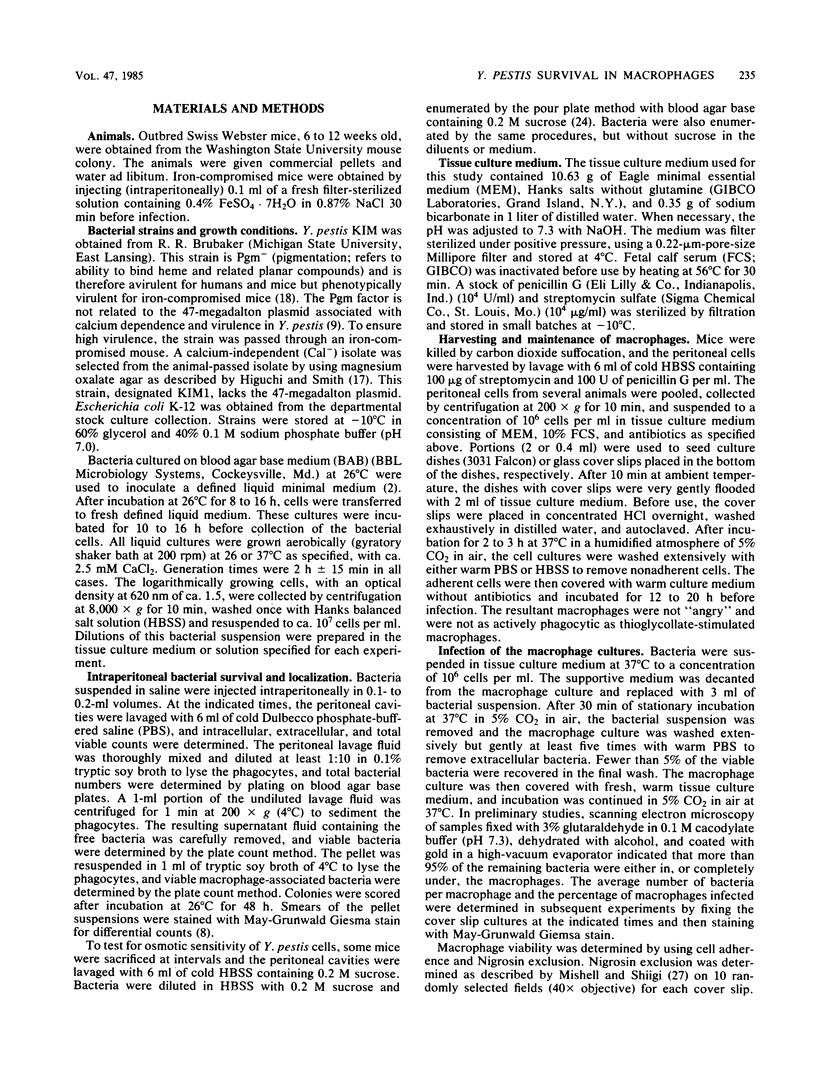
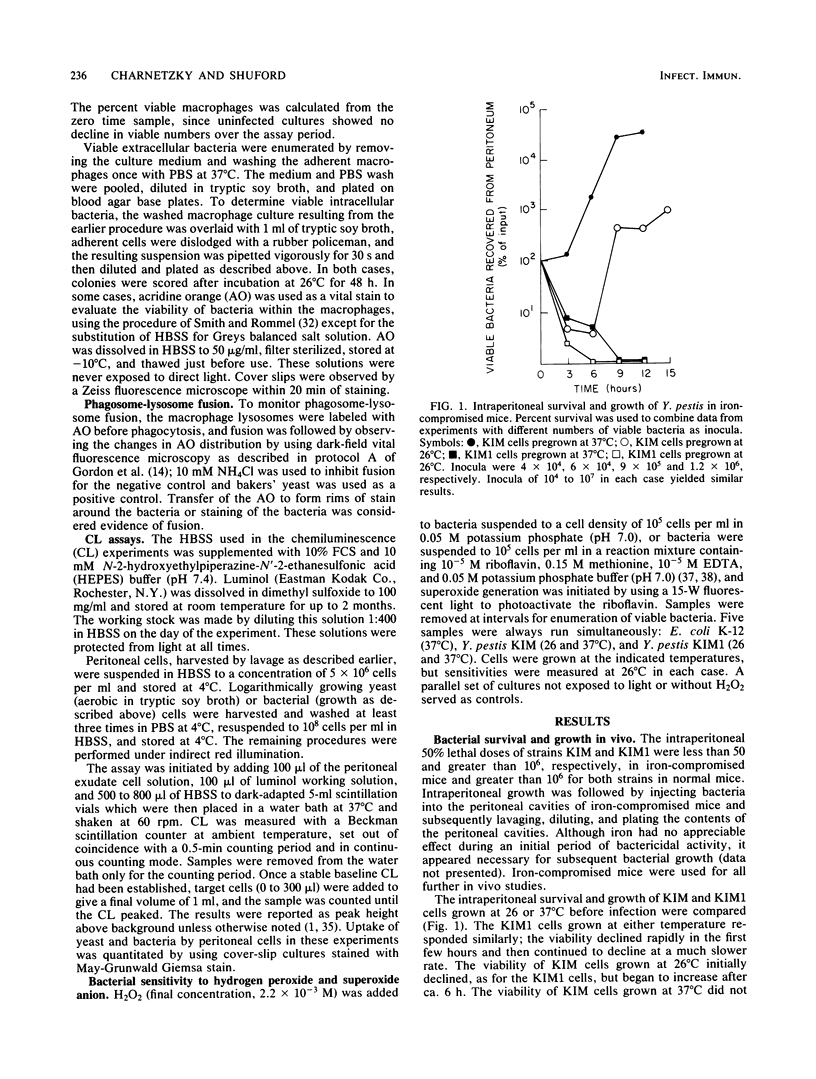
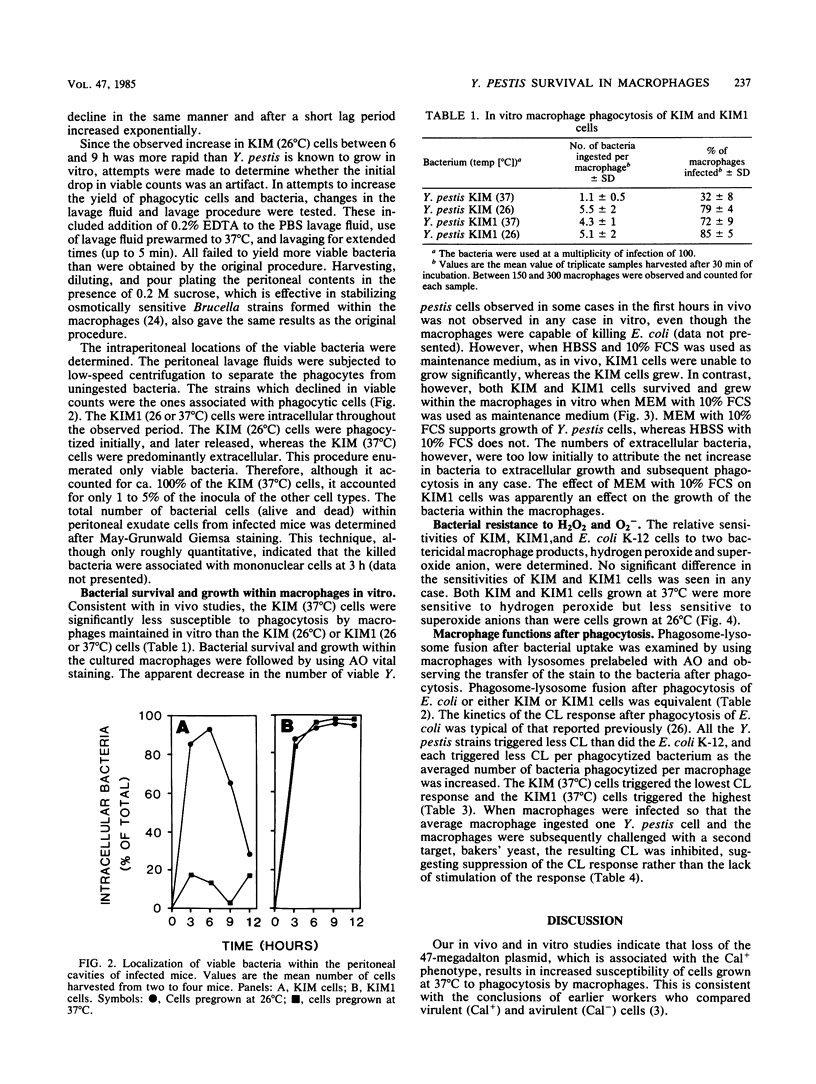
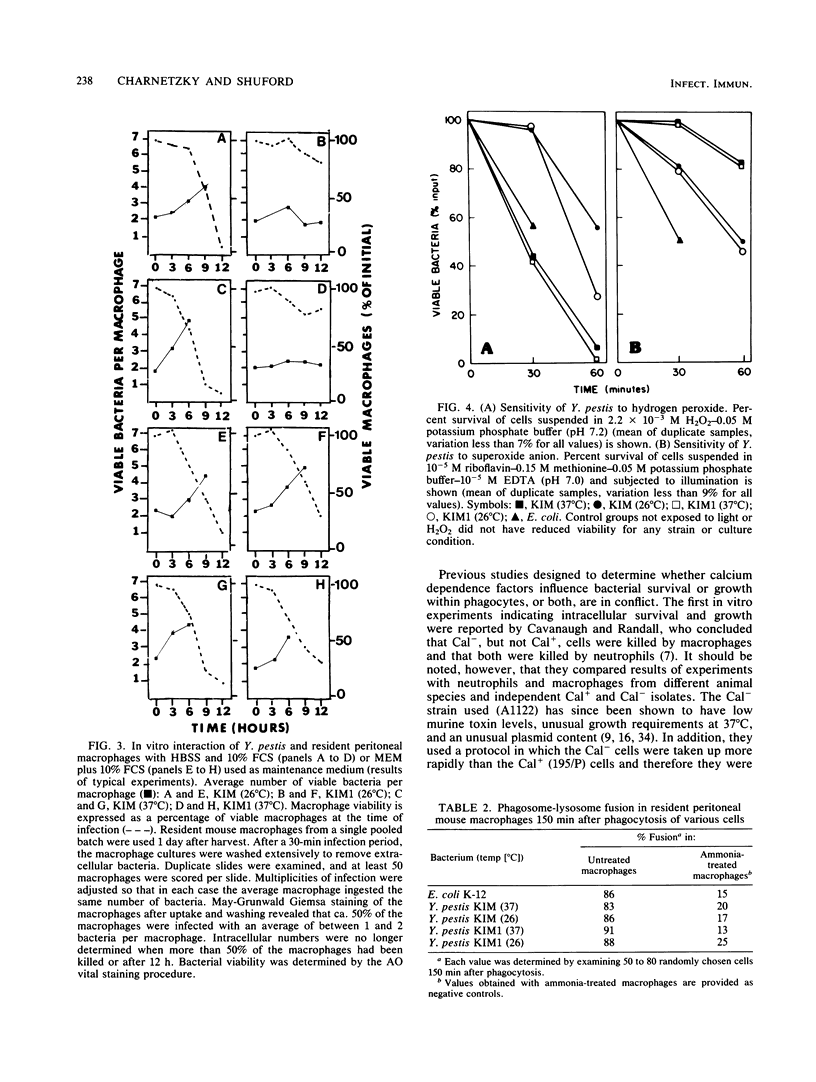
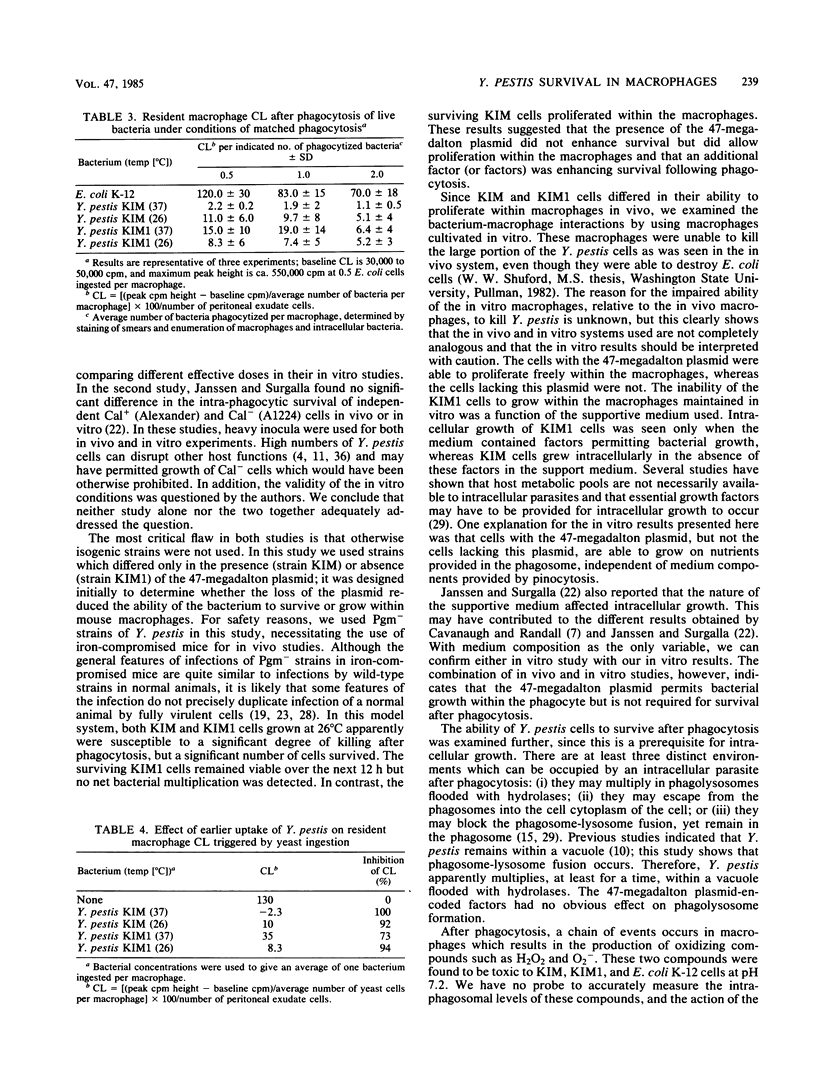
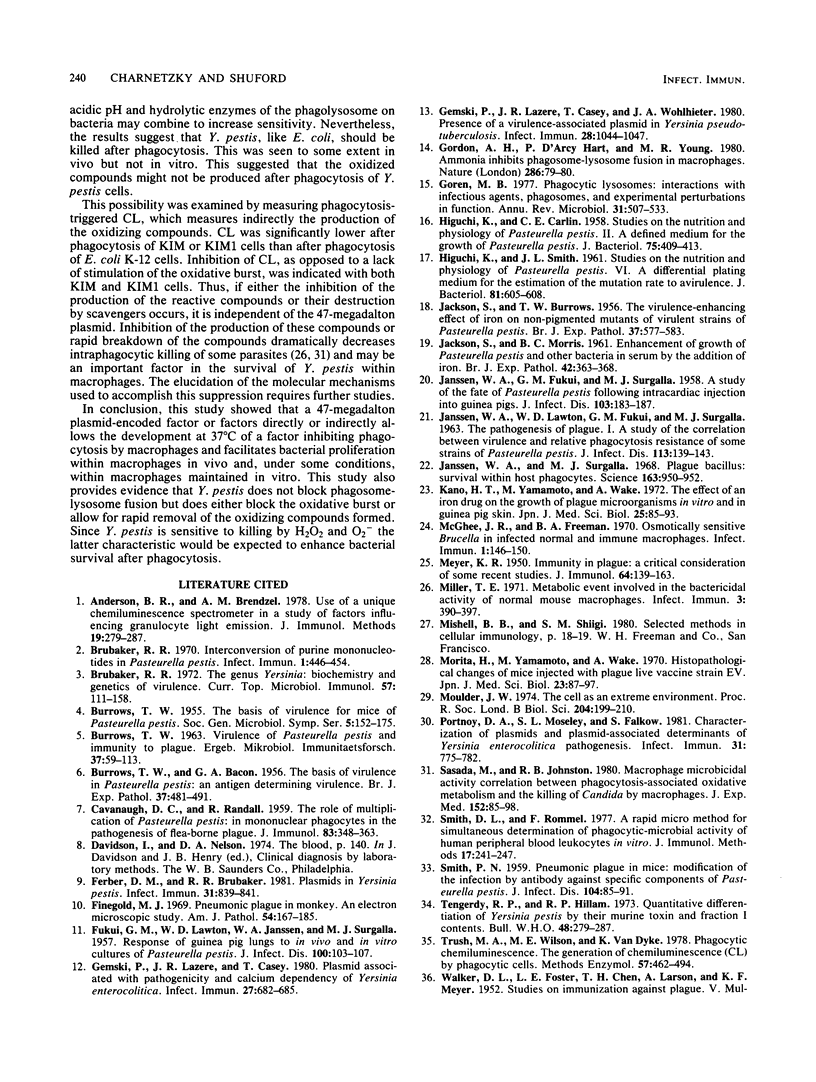
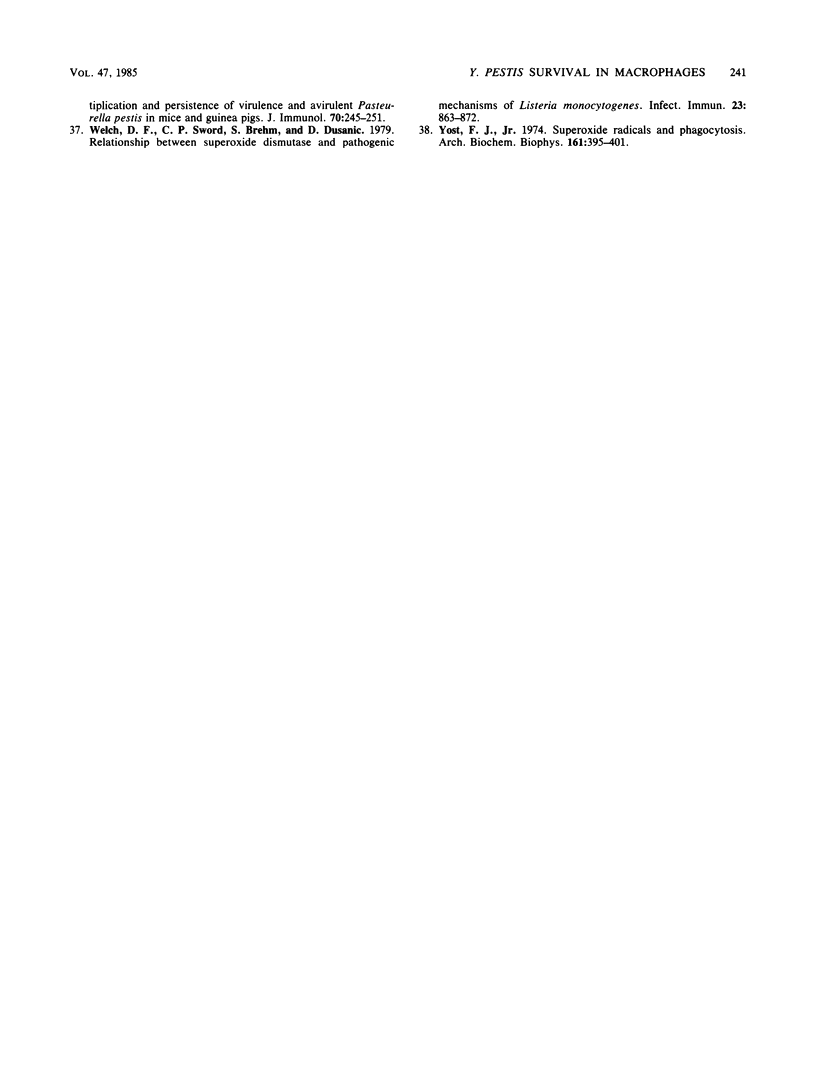
Selected References
These references are in PubMed. This may not be the complete list of references from this article.
- Andersen B. R., Brendzel A. M. Use of a unique chemiluminescence spectrometer in a study of factors influencing granulocyte light emission. J Immunol Methods. 1978;19(2-3):279–287. doi: 10.1016/0022-1759(78)90187-4. [DOI] [PubMed] [Google Scholar]
- BACON G. A., BURROWS T. W. The basis of virulence in Pasteurella pestis: an antigen determining virulence. Br J Exp Pathol. 1956 Oct;37(5):481–493. [PMC free article] [PubMed] [Google Scholar]
- BURROWS T. W., JACKSON S. The virulence-enhancing effect of iron on nonpigmented mutants of virulent strains of Pasteurella pestis. Br J Exp Pathol. 1956 Dec;37(6):577–583. [PMC free article] [PubMed] [Google Scholar]
- BURROWS T. W. VIRULENCE OF PASTEURELLA PESTIS AND IMMUNITY TO PLAGUE. Ergeb Mikrobiol Immunitatsforsch Exp Ther. 1963;37:59–113. doi: 10.1007/978-3-662-36742-1_2. [DOI] [PubMed] [Google Scholar]
- Brubaker R. R. Interconversion of Purine Mononucleotides in Pasteurella pestis. Infect Immun. 1970 May;1(5):446–454. doi: 10.1128/iai.1.5.446-454.1970. [DOI] [PMC free article] [PubMed] [Google Scholar]
- Brubaker R. R. The genus Yersinia: biochemistry and genetics of virulence. Curr Top Microbiol Immunol. 1972;57:111–158. doi: 10.1007/978-3-642-65297-4_4. [DOI] [PubMed] [Google Scholar]
- CAVANAUGH D. C., RANDALL R. The role of multiplication of Pasteurella pestis in mononuclear phagocytes in the pathogenesis of flea-borne plague. J Immunol. 1959 Oct;83:348–363. [PubMed] [Google Scholar]
- FUKUI G. M., LAWTON W. D., JANSSEN W. A., SURGALLA M. J. Response of guinea pig lungs to in vivo and in vitro cultures of Pasteurella pestis. J Infect Dis. 1957 Jan-Feb;100(1):103–107. doi: 10.1093/infdis/100.1.103. [DOI] [PubMed] [Google Scholar]
- Ferber D. M., Brubaker R. R. Plasmids in Yersinia pestis. Infect Immun. 1981 Feb;31(2):839–841. doi: 10.1128/iai.31.2.839-841.1981. [DOI] [PMC free article] [PubMed] [Google Scholar]
- Finegold M. J. Pneumonic plague in monkeys. An electron microscopic study. Am J Pathol. 1969 Feb;54(2):167–185. [PMC free article] [PubMed] [Google Scholar]
- Gemski P., Lazere J. R., Casey T. Plasmid associated with pathogenicity and calcium dependency of Yersinia enterocolitica. Infect Immun. 1980 Feb;27(2):682–685. doi: 10.1128/iai.27.2.682-685.1980. [DOI] [PMC free article] [PubMed] [Google Scholar]
- Gemski P., Lazere J. R., Casey T., Wohlhieter J. A. Presence of a virulence-associated plasmid in Yersinia pseudotuberculosis. Infect Immun. 1980 Jun;28(3):1044–1047. doi: 10.1128/iai.28.3.1044-1047.1980. [DOI] [PMC free article] [PubMed] [Google Scholar]
- Gordon A. H., Hart P. D., Young M. R. Ammonia inhibits phagosome-lysosome fusion in macrophages. Nature. 1980 Jul 3;286(5768):79–80. doi: 10.1038/286079a0. [DOI] [PubMed] [Google Scholar]
- Goren M. B. Phagocyte lysosomes: interactions with infectious agents, phagosomes, and experimental perturbations in function. Annu Rev Microbiol. 1977;31:507–533. doi: 10.1146/annurev.mi.31.100177.002451. [DOI] [PubMed] [Google Scholar]
- HIGUCHI K., CARLIN C. E. Studies on the nutrition and physiology of Pasteurella pestis. II. A defined medium for the growth of Pasteurella pestis. J Bacteriol. 1958 Apr;75(4):409–413. doi: 10.1128/jb.75.4.409-413.1958. [DOI] [PMC free article] [PubMed] [Google Scholar]
- HIGUCHI K., SMITH J. L. Studies on the nutrition and physiology of Pasteurella pestis. VI. A differential plating medium for the estimation of the mutation rate to avirulence. J Bacteriol. 1961 Apr;81:605–608. doi: 10.1128/jb.81.4.605-608.1961. [DOI] [PMC free article] [PubMed] [Google Scholar]
- JACKSON S., MORRIS B. C. Enhancement of growth of Pasteurella pestis and other bacteria in serum by the addition of iron. Br J Exp Pathol. 1961 Aug;42:363–368. [PMC free article] [PubMed] [Google Scholar]
- JANSSEN W. A., FUKUI G. M., SURGALLA M. J. A study of the fate of Pasteurella pestis following intracardial injection into guinea pigs. J Infect Dis. 1958 Sep-Oct;103(2):183–187. doi: 10.1093/infdis/103.2.183. [DOI] [PubMed] [Google Scholar]
- JANSSEN W. A., LAWTON W. D., FUKUI G. M., SURGALLA M. J. THE PATHOGENESIS OF PLAGUE. I. A STUDY OF THE CORRELATION BETWEEN VIRULENCE AND RELATIVE PHAGOCYTOSIS RESISTANCE OF SOME STRAINS OF PASTEURELLA PESTIS. J Infect Dis. 1963 Sep-Oct;113:139–143. doi: 10.1093/infdis/113.2.139. [DOI] [PubMed] [Google Scholar]
- Janssen W. A., Surgalla M. J. Plague bacillus: survival within host phagocytes. Science. 1969 Feb 28;163(3870):950–952. doi: 10.1126/science.163.3870.950. [DOI] [PubMed] [Google Scholar]
- MEYER K. F. Immunity in plague; a critical consideration of some recent studies. J Immunol. 1950 Mar;64(3):139–163. [PubMed] [Google Scholar]
- McGhee J. R., Freeman B. A. Osmotically sensitive Brucella in infected normal and immune macrophages. Infect Immun. 1970 Feb;1(2):146–150. doi: 10.1128/iai.1.2.146-150.1970. [DOI] [PMC free article] [PubMed] [Google Scholar]
- Miller T. E. Metabolic event involved in the bactericidal activity of normal mouse macrophages. Infect Immun. 1971 Mar;3(3):390–397. doi: 10.1128/iai.3.3.390-397.1971. [DOI] [PMC free article] [PubMed] [Google Scholar]
- Morita H., Yamamoto M., Wake A. Histopathological changes of mice injected with plague live vaccine strain EV. Jpn J Med Sci Biol. 1970 Apr;23(2):87–97. doi: 10.7883/yoken1952.23.87. [DOI] [PubMed] [Google Scholar]
- Moulder J. W. The cell as an extreme environment. Proc R Soc Lond B Biol Sci. 1979 Apr 11;204(1155):199–210. doi: 10.1098/rspb.1979.0022. [DOI] [PubMed] [Google Scholar]
- Portnoy D. A., Moseley S. L., Falkow S. Characterization of plasmids and plasmid-associated determinants of Yersinia enterocolitica pathogenesis. Infect Immun. 1981 Feb;31(2):775–782. doi: 10.1128/iai.31.2.775-782.1981. [DOI] [PMC free article] [PubMed] [Google Scholar]
- SMITH P. N. Pneumonic plague in mice: modification of the infection by antibody against specific components of Pasteurella pestis. J Infect Dis. 1959 Jan-Feb;104(1):85–91. doi: 10.1093/infdis/104.1.85. [DOI] [PubMed] [Google Scholar]
- Sasada M., Johnston R. B., Jr Macrophage microbicidal activity. Correlation between phagocytosis-associated oxidative metabolism and the killing of Candida by macrophages. J Exp Med. 1980 Jul 1;152(1):85–98. doi: 10.1084/jem.152.1.85. [DOI] [PMC free article] [PubMed] [Google Scholar]
- Smith D. L., Rommel F. A rapid micro method for the simultaneous determination of phagocytic-microbiocidal activity of human peripheral blood leukocytes in vitro. J Immunol Methods. 1977;17(3-4):241–247. doi: 10.1016/0022-1759(77)90106-5. [DOI] [PubMed] [Google Scholar]
- Tengerdy R. P., Hillam R. P. Quantitative differentiation of Yersinia pestis strains by their murine toxin and fraction I contents. Bull World Health Organ. 1973;48(3):279–287. [PMC free article] [PubMed] [Google Scholar]
- Tsukano H., Yamamoto M., Wake A. The effect of an iron drug on the growth of plague microorganisms in vitro and in guinea pig skin. Jpn J Med Sci Biol. 1972 Apr;25(2):85–93. doi: 10.7883/yoken1952.25.85. [DOI] [PubMed] [Google Scholar]
- WALKER D. L., FOSTER L. E., CHEN T. H., LARSON A., MEYER K. F. Studies on immunization against plague. V. Multiplication and persistence of virulent and avirulent Pasteurella pestis in mice and guinea pigs. J Immunol. 1953 Mar;70(3):245–252. [PubMed] [Google Scholar]
- Welch D. F., Sword C. P., Brehm S., Dusanic D. Relationship between superoxide dismutase and pathogenic mechanisms of Listeria monocytogenes. Infect Immun. 1979 Mar;23(3):863–872. doi: 10.1128/iai.23.3.863-872.1979. [DOI] [PMC free article] [PubMed] [Google Scholar]
- Yost F. J., Jr, Fridovich I. Superoxide radicals and phagocytosis. Arch Biochem Biophys. 1974 Apr 2;161(2):395–401. doi: 10.1016/0003-9861(74)90320-8. [DOI] [PubMed] [Google Scholar]


